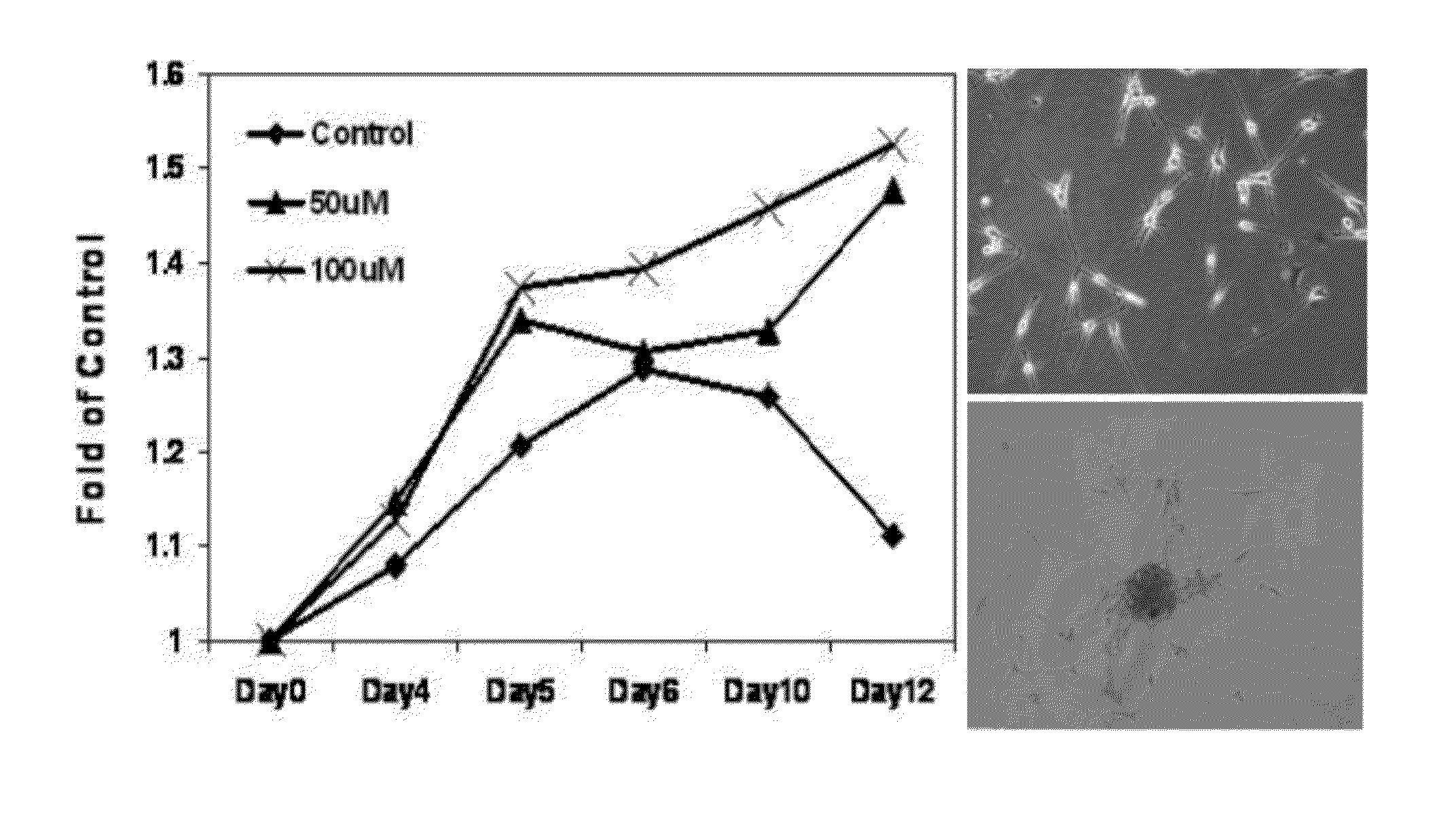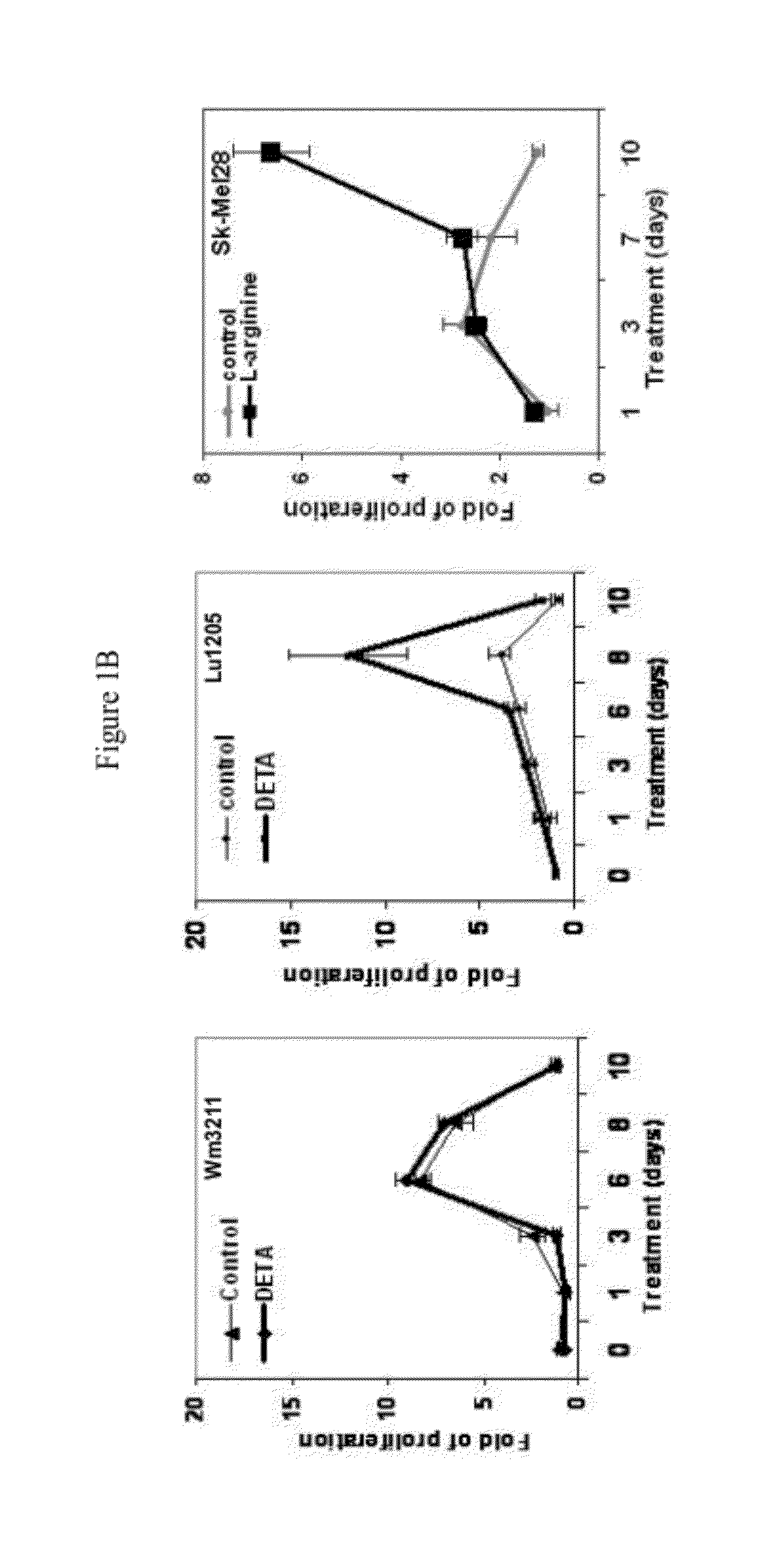Specific nNOS Inhibitors for the Therapy And Prevention Of Human Melanoma
a technology of nitric oxide and melanoma, which is applied in the field of specific nnos inhibitors for the therapy and prevention of human melanoma, can solve the problems of increased proliferation, limited characterization of the effect of no stress and its detailed molecular mechanisms, and dna damage, and achieve the effect of reducing nitric oxide stress
- Summary
- Abstract
- Description
- Claims
- Application Information
AI Technical Summary
Benefits of technology
Problems solved by technology
Method used
Image
Examples
example 1
[0068]NO stress stimulates the proliferation of melanoma cells in vitro. NO donor DETA / NO (1-[N-(2-Aminoethyl)-N-(2-ammonioethyl)amino]diazen-1-ium-1,2-diolate) was utilized to mimic NO stress in cell culture media. As shown in FIG. 1A, in human primary melanocytes, cell proliferation measured by the MTT colorimetric assay in a 12-day period was significantly stimulated by DETA / NO exposure compared to control. At the end of the experiment, melanocytes incubated with DETA / NO were still proliferative, while the proliferation of control cells peaked by day 6 and started to drop. When extending the exposure time of DETA / NO in melanocytes to 10 weeks, it was observed that many foci formed in culture dishes and cells exhibited notable vertical growth potential: these foci were sub-cloned and re-seeded in a low density and showed evidence of continued foci formation. Marked stimulation of proliferation was also evident in human metastatic Lul205 and SK-Mel28 cells with DETA / NO (100 μM) tre...
example 2
[0071]nNOS expression is elevated melanoma compared to normal melanocytes, which is sensitive to UV radiation and growth factors. First, as shown in FIG. 2A, an immunoblotting assay revealed that the nNOS expression levels in human melanoma cell lines were much higher compared to levels in primary normal human melanocytes. Similar experiments were also carried out with mouse cells since UVB-induced melanoma in the HGF / SF transgenic mouse melanoma model is well characterized and recapitulates fairly well the etiology and histopathology of human melanoma. (Noonan F. P., Otsuka T., Bang S., Anver M. R., Merlino G. Accelerated ultraviolet radiation-induced carcinogenesis in hepatocyte growth factor / scatter factor transgenic mice. Cancer Res. 2000; 60:3738-43.) Three mouse melanoma cell lines established from the developed lesions have been used as the screening panel for translational or mechanistic studies. Similar to human cells, immunoblotting study also showed marked elevated nNOS e...
example 3
[0075]nNOS silencing was associated with reduced invasion potential in metastatic melanoma cells. Using siRNA transfection, nNOS was transiently knocked down in two metastatic melanoma cells (A375 and Lul205) (FIG. 3A). Immunoblotting analysis showed that with nNOS depletion, the expression levels of JunD, MMP-1, APE / Ref-1, and Bc1-2 were significantly reduced. Consistently, it was found that the invasion potential was also decreased in nNOS-depleted melanoma cells (FIG. 3B).
PUM
| Property | Measurement | Unit |
|---|---|---|
| Stereoisomer | aaaaa | aaaaa |
Abstract
Description
Claims
Application Information
 Login to View More
Login to View More - R&D
- Intellectual Property
- Life Sciences
- Materials
- Tech Scout
- Unparalleled Data Quality
- Higher Quality Content
- 60% Fewer Hallucinations
Browse by: Latest US Patents, China's latest patents, Technical Efficacy Thesaurus, Application Domain, Technology Topic, Popular Technical Reports.
© 2025 PatSnap. All rights reserved.Legal|Privacy policy|Modern Slavery Act Transparency Statement|Sitemap|About US| Contact US: help@patsnap.com



